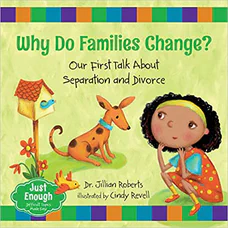Why Do Families Change?
Our first talk about separation and divorce
Written by Dr. Jillian Roberts
Illustrated by Cindy Revell
32 pages
•
Published 2020 (Orca Book Publishers)

Recommended Age Range: Preschool through 1st grade.
Publisher's Summary:
Separation and divorce are difficult on the entire family. Often young children blame themselves or are unsure of their place in the family if these events occur. Child psychologist Dr. Jillian Roberts designed the Just Enough series to empower parents/caregivers to start conversations with young ones about difficult or challenging subject matter.

Dr. Annie's Takeaways
Recommended for: This book is a calm, normalizing introduction to divorce and separation, and it provides recommendations for coping with upcoming changes. The illustrations include families of color and queer parents, so it is particularly well-suited for families looking for a book with representation beyond White, heterosexual parents. No specific custody arrangements are mentioned in the book.
Would a child like it? This isn’t the type of book that a child will enjoy in the traditional sense of the word. But it is fairly comforting and straight-forward, and it does a nice job normalizing divorce/ separation, which a lot of children will appreciate.
Tone: Informative, reassuring
Story Quality: Written in a question-and-answer format, this book explains what separation and divorce are, how this might make a child feel, and how they can best cope with these feelings (talk with a trusted adult, create new traditions, etc). This book really made an effort to be relevant to a diversity of family structures (e.g., it includes a page about parents who are common-law married and refers to parents “divorcing or separating” throughout the book). The book has very few words per page, and the Q&A format is accessible. I particularly liked the pages that talked about parents divorcing in order to “have a chance …to make their homes happy.” It is a nice way to talk about reasons for divorce and sets a hopeful tone. Some of the definitions used in the book are fairly clear, but there are a few that I wish were a little more concrete and might be confusing to younger kids (e.g., “Separation is when a couple takes time apart from each other”; “When a couple divorces, it means they no longer share their life”). The definition of common-law marriage provided in the book isn’t totally accurate (“[to] commit to a life together without getting married”), but it also doesn’t really matter. Whether parents are married, common-law married, or committed and living together, it’s equally difficult for a child when they break up.
Illustrations: The illustrations have a sweet and happy cartoon-like feel to them.
Representation: There are a handful of different families represented in the illustrations, including a White family with two moms and a son; a family of color (possibly Black or Latinx) with a mom, dad, daughter, and son; and an Asian or Asian-American family with a mom, dad, and child. There are several additional couples illustrated in the book, including two men getting married, and a biracial couple “in love.” There is a page with pictures of three couples in wedding clothes, which includes a man and a woman in traditional western wedding clothes, two men in suits under a chuppah-like structure, and a man and a woman dressed in traditional Chinese wedding attire (I unfortunately don’t have the expertise to know if the latter is accurate). Marriage and “common-law” marriage (described as being committed without getting married) are both mentioned at the beginning of the book and the wording “separating or getting a divorce” and “separated or divorced” is used throughout the book.
Psychological Practices: This book addresses common childhood worries related to divorce–e.g., it reminds children that a divorce is never their fault and that it doesn’t mean that parents will stop loving their children. It normalizes kids feeling “sad, scared, and even angry,” and it encourages kids to talk with and ask questions to someone they trust, “like your parents, a teacher, a counselor, or another family member,” as well as to create new traditions with their parents.
Concerns: None
